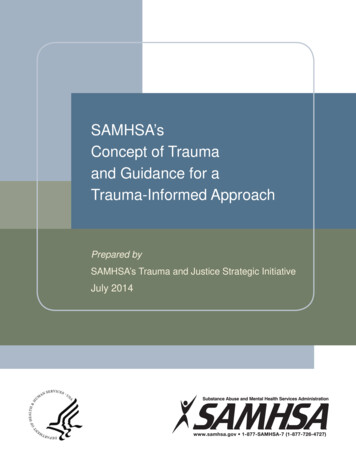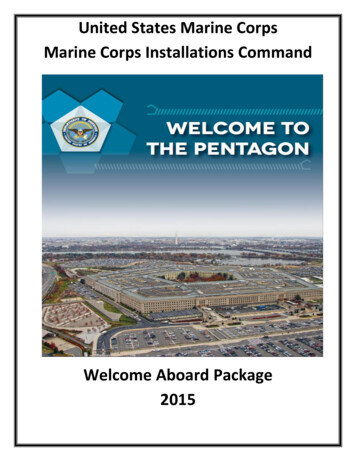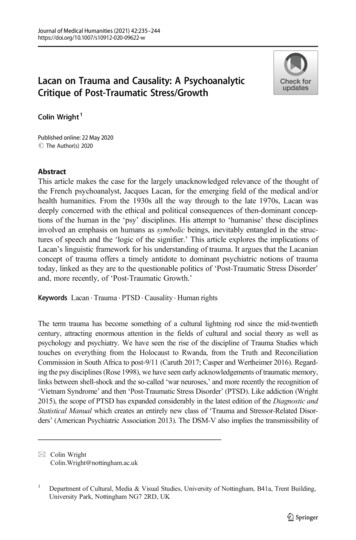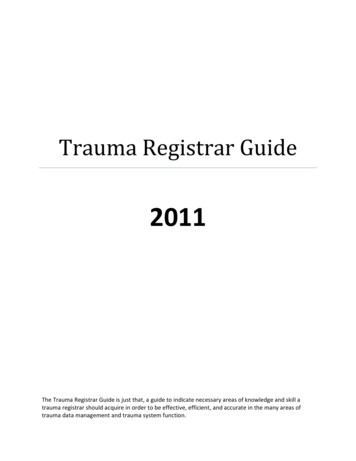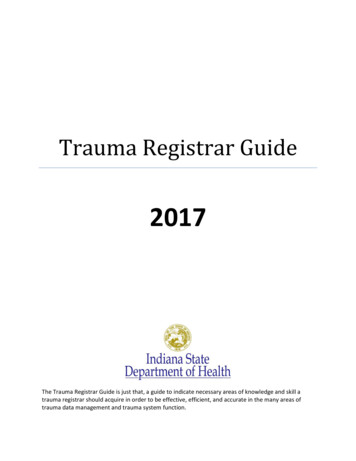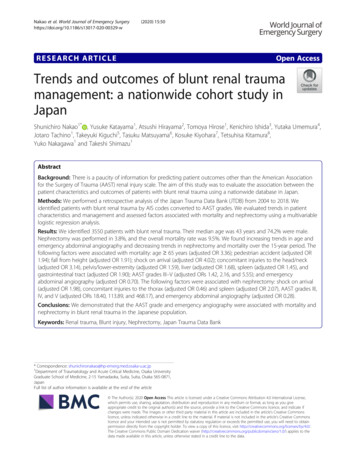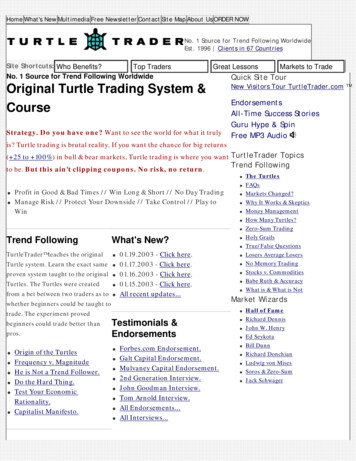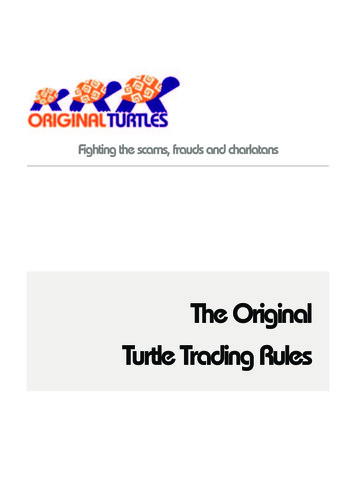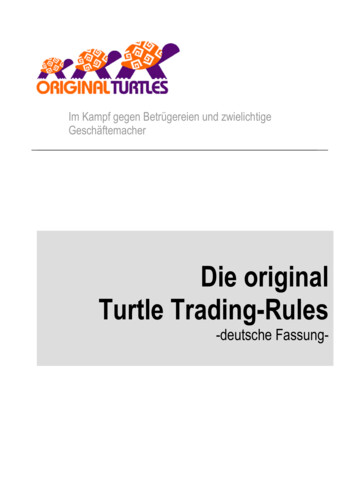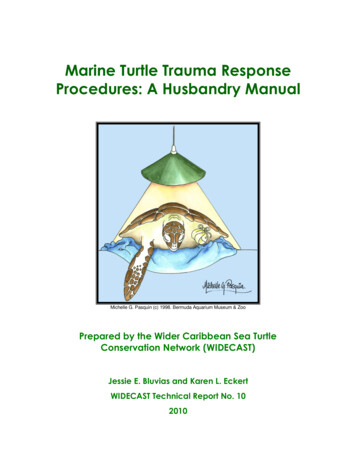
Transcription
Marine Turtle Trauma ResponseProcedures: A Husbandry ManualMichelle G. Pasquin (c) 1998. Bermuda Aquarium Museum & ZooPrepared by the Wider Caribbean Sea TurtleConservation Network (WIDECAST)Jessie E. Bluvias and Karen L. EckertWIDECAST Technical Report No. 102010
For bibliographic purposes, this document should be cited as:Bluvias, Jessie E. and Karen L. Eckert. 2010. Marine Turtle Trauma Response Procedures: A Husbandry Manual. Wider Caribbean Sea Turtle Conservation Network(WIDECAST) Technical Report No. 10. Ballwin, Missouri. 100 pp.ISSN: 1930-3025Copies of this publication may be obtained from:Wider Caribbean Sea Turtle Conservation Network (WIDECAST)1348 Rusticview DriveBallwin, Missouri 63011 USAPhone: (314) 954-8571Email: keckert@widecast.orgOnline at www.widecast.orgGenerously supported by:The Beverly Foundation
Marine Turtle Trauma ResponseProcedures: A Husbandry ManualJessie E. Bluvias, MEMProject Officer, WIDECASTKaren L. Eckert, Ph.D.Executive Director, WIDECAST2010
Bluvias and Eckert (2010) Marine Turtle Husbandry ManualWIDECAST Technical Report No. 10PREFACE AND INTENTFor three decades the Wider Caribbean Sea Turtle Conservation Network (WIDECAST), with CountryCoordinators in more than 40 Caribbean nations and territories, has linked scientists, conservationists, resource managers, resource users, policy-makers, industry groups, educators, and other stakeholders together in a collective effort to develop a unified management framework, and to promote aregional capacity to design and implement scientifically sound sea turtle management programs.As a Partner Organization of the UNEP Caribbean Environment Programme and its Regional Programme for Specially Protected Areas and Wildlife (SPAW), WIDECAST is designed to address research and management priorities at national and regional levels, both for sea turtles and for the habitats upon which they depend. We focus on bringing the best available science to bear on contemporary management and conservation issues, empowering stakeholders to make effective use of thatscience in the policy-making process, and providing an operational mechanism and a framework forcooperation at all levels, both within and among nations.Network participants throughout the region are committed to working collaboratively to develop theircollective capacity to manage shared sea turtle resources. By bringing people together, and by encouraging inclusive management planning, WIDECAST is helping to ensure that utilization practices,whether consumptive or non-consumptive, do not undermine sea turtle survival over the long term.Among these capacity building initiatives is WIDECAST’s regional “Sea Turtle Trauma ResponseCorps” (STTRC). The aim of the STTRC is to strengthen and coordinate the efforts of people throughout the Wider Caribbean Region to respond to sea turtles in crisis, whether at sea or stranded alongthe shoreline. Based on recommendations of the 2004 Annual General Meeting of WIDECAST (heldin San José, Costa Rica), the STTRC initiative includes the development of standard guidelines andcriteria, reporting forms, database management software, and training for field staff and volunteers,natural resource managers, veterinarians, and animal rescue practitioners.Following our 2006 “first response” field guide, it became clear that procedures and strategies werealso needed to guide necessary efforts to provide adequate housing and care for sea turtles requiringa period of supervised rehabilitation after experiencing the effects of physical trauma or environmentalstressors. Through literature research and extensive peer-review, we have summarized best practicesrelated to human health and safety, sea turtle handling and transport, facilities design and requirements (maintaining turtles in and out of water, lighting and photoperiod, temperature control, life support systems, water system set-up, water quality testing, sanitization), diet and feeding, enrichment,emergency procedures, and release. Appendices provide a species identification guide, documentation forms, various plans and diagrams (sea turtle stretcher, tank dividers, water systems), recipes,quarantine protocols, and euthanasia. It is the first resource of its kind.Nothing in this manual should be construed as an endorsement of keeping sea turtles in captivity unnecessarily, or for reasons of profiteering. Nor do we suggest that every Caribbean nation invest in aprofessional rescue or rehabilitation facility. We do, however, believe that when good can be done fora sick or injured animal, it is important that the actions taken are in line with professional and humanepractices. The survival of every endangered sea turtle is important in today’s world, and we hope thatthe information provided herein increases the probability that a sick or injured turtle will be given a“second chance” to resume a normal life in the wild.Karen L. Eckert, Ph.D.Executive DirectorWIDECAST1
Bluvias and Eckert (2010) Marine Turtle Husbandry ManualWIDECAST Technical Report No. 10ACKNOWLEDGEMENTSFor contributing their time, assistance, and expert guidance in the early development of these standards, the authors are very grateful to Eric Anderson, Lynne Byrd, Petra Cunningham-Smith, CharlesManire, Kelly Martin, Molly Pastorello, Renee Romanowski, and David Smith of Mote Marine Laboratory; Caitlin Cisek and Kelly Thorvalson of the South Carolina Aquarium (SCA); Robert George, TracyHeard, Mark Swingle, and the Fishes Department at the Virginia Aquarium and Marine Science Center (VAMSC); Wendy Walton and the Stranding Response Team of the Virginia Aquarium StrandingResponse Program; the staff of the North Carolina Aquarium at Pine Knoll Shores; Michelle Bauer ofthe Volusia County Marine Science Center; Rhema Bjorkland of Duke University’s Center for MarineConservation in Beaufort, North Carolina; and Jeanette Wyneken of Florida Atlantic University.The document benefited significantly from a thorough peer-review by Jean Beasley (Director, KarenBeasley Sea Turtle Rescue and Rehabilitation Center, USA), Flegra Bentivegna (Curator, NaplesAquarium, Italy), Shane Boylan, DVM (Veterinarian, South Carolina Aquarium, USA), Claire Cayol,DVM (Veterinarian, DIREN, Martinique, French West Indies), Scott Eckert, Ph.D. (Research Scientist,Duke University), Beth Firchau (Curator of Fishes, VAMSC), Robert George, DVM (Head Veterinarian, VAMSC), Hedelvy Guada (CICTMAR, Venezuela), Craig Harms, DVM (North Carolina StateUniversity College of Veterinary Medicine, USA), Julia Horrocks, Ph.D. (Director, Barbados Sea TurtleProject; Professor, University of the West Indies), Michelle Kaylor (Rehabilitation Coordinator, GeorgiaSea Turtle Center, USA), Frédéric Leveque, DVM (Veterinarian, l'Aquarium de Guadeloupe, FrenchWest Indies), Carl Lloyd (Ocean Spirits, Grenada), Charles Manire, DVM (Veterinarian, Mote MarineLaboratory, USA, and Atlantis Paradise Island, Bahamas), Nancy Mettee, DVM (Loggerhead MarineLife Center, USA), Terry Norton, DVM (Director, Georgia Sea Turtle Center, USA), Maria Luz Parga,DVM (Veterinarian, SUBMON, Spain), Michelle Sattler (Collections Supervisor, John G. SheddAquarium, USA), Lory Scott (Old Dominion University, USA), Andrew Stamper, DVM (Veterinarian,Mote Marine Laboratory, USA), Mark Swingle (Director, Research and Conservation, VAMSC), LesleyStokes and Wendy Teas (NOAA Southeast Fisheries Science Center), Kelly Thorvalson (Manager,Sea Turtle Rescue Program, SCA), Jeanette Wyneken, Ph.D. (Florida Atlantic University, USA), andStuart Wynne (Department of Fisheries and Marine Resources, Anguilla).Edward Lockhart and Michele Lamping (North Carolina Aquarium at Pine Knoll Shores) created theholding environment diagrams, and Michele Lamping co-authored Section V: Holding Environment.Lisa Wright (VAMSC) contributed her knowledge on creating tank dividers. Stuart May (North CarolinaAquarium at Pine Knoll Shores), Barbara Bergwerf and Kelly Thorvalson (SCA), Kelly Martin andRenee Romanowski (Mote Marine Laboratory), and Mark Swingle (VAMSC), among others, kindlydonated photographs and other illustrations.The senior author’s research and summer internships in 2007-2008 would not have been possiblewithout a grant from the Nicholas School of the Environment’s Environmental Internship Fund (DukeUniversity), and the kindness of those who provided me with local housing: Deb and Rick LaStella inBradenton, Florida; Diane Lauritsen in Mount Pleasant, South Carolina; and Maylon and CharlotteWhite in Virginia Beach, Virginia. Major funding for the development, peer-review, and printing of thisManual was provided by the WIDECAST network (http://www.widecast.org), The Beverly Foundation,Atlantis Paradise Island (http://www.atlantis.com/), Humane Society International (http://www.hsi.org/),and the Pegasus Foundation (http://www.pegasusfoundation.org/). Finally, I gratefully acknowledgeDr. Karen Eckert for introducing me to this project, advising me along the way, and giving me endlesssupport and enthusiastic encouragement; James for his patience and encouragement; and my friendsand family for their constant love and support – thank you all for believing in me and for being a part ofmy journey. As I promised years ago, this one is dedicated to you, Mom, with love.2
Bluvias and Eckert (2010) Marine Turtle Husbandry ManualWIDECAST Technical Report No. 10TABLE OF CONTENTSPreface and IntentAcknowledgementsTable of ContentsSummaries and Checklists1236I. OverviewWIDECAST Sea Turtle Trauma Response Corps (STTRC)Cautionary RemarksWant to Know More?Internet Resources to Inform and Guide Husbandry EffortsInternet Links to Sea Turtle Rescue and Rehabilitation Facilities789101011II. The EssentialsHuman Health and SafetyStaff Qualifications and ResponsibilitiesFacility Requirements and SuppliesRecord Keeping and DocumentationSea Turtle Anatomy Guide121212131314III. Handling and TransportProcedures and Advice: Handling a Live TurtleRetrieveRestrainComfortReturnProcedures and Advice: Transporting a Live TurtleAir Transport1515151616161717IV. Admitting a PatientAssessment and DocumentationTherapeuticsA Note about Emergency CarePublished Drug Dosing Studies in Sea TurtlesA Note about Leatherback Turtles181818192021V. Holding EnvironmentFacilityMaintaining Turtles in WaterConsiderationsMaterialsSeparationSummary of Holding Tank RequirementsMaintaining Turtles out of WaterBasic Set-UpAdvanced Set-UpLighting and PhotoperiodOutdoor FacilitiesIndoor Facilities222222222323242525252626263
Bluvias and Eckert (2010) Marine Turtle Husbandry ManualWIDECAST Technical Report No. 10Temperature ControlSurface Area and VolumeWater TemperatureAir TemperatureSpray BarsChillers and HeatersLife Support SystemsPumps and Basic PlumbingFiltersSterilizersWater System Set-upOpen, or Flow-through SystemSemi-open SystemClosed SystemWater Quality ter ChangesCleaning UtensilsDischarging Waste WaterSummary of Water Quality 6363637VI. DietFood SelectionFood QuantityFood Storage and PreparationSummary of Food Selection and PreparationFeeding Techniques and TipsFree FeedingAssisted FeedingTube FeedingOral Medications/VitaminsOther Tips3838383940404040414343VII. EnrichmentFood ItemsLive FoodIce BlocksDrilled PipesFeeding MatNon-food ItemsRocksWaterfallsRefugia (Hiding Places)Back Scratcher44444444444445454545454
Bluvias and Eckert (2010) Marine Turtle Husbandry ManualWIDECAST Technical Report No. 10VIII. ReleaseFinal Assessment and ClearanceTaggingFlipper TagsPIT Tags4646474749IX. Hatchling HusbandryTemporary Holding of Healthy HatchlingsHolding Environment for Sick or Injured HatchlingsIdentification MarkingDietRelease525253545454X. Emergency Preparations and Procedures56XI. Mortality and NecropsyEuthanasiaNecropsy575757XII. Literature Cited59Appendix A:Appendix B:Appendix C:Appendix D:Appendix E:Appendix F:Appendix G:Appendix H:Appendix I:667382848586889396Species IdentificationSample Documentation FormsCustomized Turtle StretcherTank DividersAdvanced Dry-Dock SetupWater System DiagramsFood GuideQuarantineEuthanasia in Sea TurtlesPhoto by Jessie Bluvias5
Bluvias and Eckert (2010) Marine Turtle Husbandry ManualWIDECAST Technical Report No. 10SUMMARIES AND CHECK LISTSInternet Resources to Inform and Guide Husbandry EffortsInternet Links to Sea Turtle Rescue and Rehabilitation FacilitiesSituations Requiring HandlingPublished Drug Dosing Studies in Sea TurtlesSummary of Holding Tank RequirementsSummary of Water Quality StandardsSummary of Food and FeedingChecklist: Procedures for Tube-Feeding a Sea TurtleChecklist: Final Assessment and Clearance for ReleaseChecklist: Equipment and Precautions for Emergency SituationsSea Turtle Necropsy Manuals and Related Resources1011152024374042465658Photos (clockwise): South Carolina Aquarium; WIDECAST; Nature Foundation of Sint Maarten; Sea Turtle Conservation Bonaire6
Bluvias and Eckert (2010) Marine Turtle Husbandry ManualWIDECAST Technical Report No. 10I. OVERVIEWPhelan and Eckert (2006) established basic guidelines and procedures for responding to sea turtlesaffected by a variety of natural (e.g., predator attacks, mating wounds, parasite infestations) and maninduced (e.g., boat strikes, entanglement and hooking, oil contamination, trash ingestion) traumas. Insome cases the animal could be released; for example after having been cleansed of oil or releasedfrom an entanglement. In other cases the recommendation was to transport the animal to a rescue/rehabilitation center or willing veterinarian for observation and/or treatment.The purpose of a rescue/rehabilitation center is to provide both immediate and longer-term care tosick and/or injured animals. The expected outcome is always that the animal will be returned to thesea as soon as practicable, enabling it to fulfill its ecological roles. Wildlife rehabilitation is sometimesridiculed as a waste of time by numerically minded conservationists who may view the effort as inconsequential in the larger scheme of things, but for endangered and threatened species, including sixspecies of Caribbean sea turtle (see Appendix A: Species Identification), every individual, especiallyof (or close to) breeding age, released back to the wild is another step toward species survival.Even when presenting severely infected injuries and/or shock, wild animals appear to demonstrate agreat capacity to cope with these injuries and will often recover if given the necessary supportivetreatment (Stocker, 2005). Notwithstanding, bringing a sea turtle into captivity, even for a short time,should be done only when absolutely necessary. Captivity requires special considerations with regardto the physical plant (e.g., access to running seawater, large animal capacity), human resources (e.g.,attendants will require a knowledge of reptile medicine and care), and the law (e.g., sea turtles areprotected in most Caribbean countries and their handling and care may require a special permit).Sick and injured sea turtles require special medical attention. Never bring a seaturtle home with the intention of caring for it yourself. In every Caribbean countryit is illegal to capture, transport, and/or possess a sea turtle during a legallyenforced closed season, which for most countries is year-around.Subjected to undue stress and without proper attention to their specific husbandry needs, the condition of a sick or injured sea turtle may worsen rather than improve. For example, incorrect intake ofcalcium and phosphorous and certain single food diets can cause metabolic bone disease and irondeficiency, respectively (George, 1997); overfeeding can contribute to intestinal blockages, floating orbloating problems (Higgins, 2003); and inappropriate food items can contribute to parasitic infections(George, 1997). Physical plant issues can also compromise proper nutrition. A lack of UV lightexposure may contribute to vitamin D deficiency, limiting the amount of calcium uptake in the intestines (Norton, 2005a; George, 1997). Turtles housed together are vulnerable to aggression, injuriesrelated to aggression, and the spread of disease, any or all of which can decrease appetite or theability to eat (George, 1997; Higgins, 2003). Finally, if the holding facility is poorly designed andmaintained, foreign objects can be swallowed or cause physical trauma, and poor water quality cancause eye irritations, all of which can contribute to malnutrition (George, 1997; Higgins, 2003).Non-nutritional related disorders can also be acquired in captivity and are directly related to commonhusbandry errors and facility design. Flow-through open water systems and closed systems can introduce or amplify bacteria, fungi, viral diseases, and parasites if water quality is not properly maintained. Constant high water temperatures can facilitate an outbreak of grey-patch disease by degrading the turtles’ immune system (Haines and Keese, 1977), and prolonged periods out of water canresult in carapace drying and scute peeling, creating a canvas for bacteria and fungi (Higgins, 2003).Turtles housed together can develop injuries (eye infections, skin lesions) from aggression or induce7
Bluvias and Eckert (2010) Marine Turtle Husbandry ManualWIDECAST Technical Report No. 10stress between individuals, exacerbating their vulnerability to infection (George, 1997; Higgins, 2003).General contact between turtles and the sharing of water systems can also aid in spreading disease.The number and variety of disorders and other problems that can occur in a disorganized or unmanaged environment can significantly hinder the ability of staff to properly rehabilitate and release seaturtles back into the wild. Therefore, correct measures must be taken to ensure the best overall practices and management, including record-keeping and documentation. With all of this in mind, thepurpose of this Husbandry Manual is to offer basic guidelines and procedures for individualswho rehabilitate sick and injured sea turtles. The guidelines are also useful when caring for seaturtles retained at facilities permitted to house them for educational display.Designed to address the needs of sea turtles suffering from the effects of physical trauma or environmental stressors, the following sections will help prevent common problems associated with rehabilitation by providing guidance on handling and transport, facilities requirements, diet and feeding, enrichment, emergency procedures, and release. Appendices provide a species identification guide, documentation forms, water system diagrams, recipes, and quarantine protocols. Written for lay and professional audiences, it is the first such resource in the Wider Caribbean Region, and is intended tomeet the needs of the Sea Turtle Trauma Response Corps organized by the Wider Caribbean SeaTurtle Conservation Network (WIDECAST).WIDECAST Sea Turtle Trauma Response Corps (STTRC)1WIDECAST, with Country Coordinators in more than 40 States and territories, is uniquely designed toaddress national and regional research, conservation, and management priorities, both for sea turtlesand for the variety of habitats upon which they depend. One such priority is to reduce the negativeconsequences of human interactions with sea turtles, as well as to facilitate the rescue and rehabilitation of injured and traumatized turtles.Delegates from more than 30 Caribbean States and territories unanimously agreed at the 2004 Annual General Meeting (AGM) of WIDECAST that a “Sea Turtle Trauma Response Corps” (STTRC) becreated to strengthen and coordinate the efforts of people throughout the Wider Caribbean Region torespond to sea turtles in crisis, whether at sea or stranded on the shoreline. The Meeting envisionedthat the STTRC would embrace interested sea turtle project staff and volunteers; veterinarians; zooand aquaria personnel; “animal rescue” center staff; divers, fishe
support and enthusiastic encouragement; James for his patience and encouragement; and my friends and family for their constant love and support – thank you all for believing in me and for being a part of my journey. As I promised
